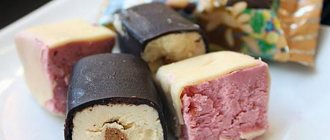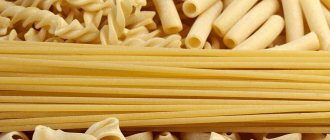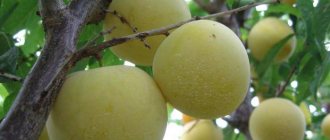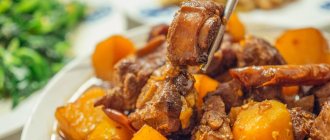Article read: 3,995
Let's figure out what asparagus the calorie content of which is 21 kcal/100 grams , we will find out why the calorie content of asparagus high and how many types there are. Asparagus or asparagus belongs to the asparagus family. There are about a hundred species of asparagus. Asparagus is grown only in dry climates.
Asparagus is very popular in diets and in proper and healthy eating, since it is considered a low-calorie product and also very nutritious.
How many calories are in asparagus
Asparagus has only 39 calories per 100 grams. Depending on how it was prepared. In any case, asparagus can be classified as a low-calorie product.
Asparagus is very rich in vitamins and microelements, so during diets, any nutritionist will include it in your daily diet.
Asparagus during your diet will provide your body with all the necessary vitamins and microelements.
Unique product
Soy asparagus, also known as fuju or yuca, is a semi-finished soybean product that the Chinese prepare as a national dish.
The main ingredient used in Korean asparagus recipes is not directly related to the plant of the same name. It is correct to call it yuca in Japanese, fuzhu in Chinese, or at least Chinese fern.
How to make asparagus in Korean if this plant is not its basis? The product is prepared from soy milk, which is boiled until a film appears on its surface - fupi. If you hang this film, it takes on an interesting elongated shape. When it dries, it becomes fuzhu.
You may be wondering what exactly is soy milk? In fact, it is ordinary soybean, crushed until smooth and then boiled.
Milk is prepared very simply:
- First, soybeans are soaked and infused in water;
- then cook over low heat, strictly observing the required proportions of soy and water;
- and at the very end they grind and decant.
The smell of such milk is quite pleasant, the color is natural, but it has no taste as such.
Another thing is the Chinese fern. Its taste is original and piquant, so having Korean asparagus salad on the table will be the highlight of your dinner party. In addition, as nutritionists note, thanks to fuzhu you can improve your health and lose excess weight.
Harm of asparagus

Despite all the positive qualities of this product, asparagus also has negative qualities, like any product. As they say, everything should be in moderation without going overboard.
Asparagus can in rare cases cause allergies. It is also not recommended to use this product if you have a stomach ulcer. Men and women are not recommended to eat asparagus if they have prostatitis and cystitis, respectively.
Asparagus and its varieties
Asparagus won human recognition a long time ago - the ancient Greeks and Romans already praised the medicinal properties of this vegetable and valued it as a culinary delicacy, although they were of little interest in the question of the calorie content of asparagus, which is popular today.
Asparagus comes in several types:
- green asparagus - always grows outdoors;
- white asparagus - in the process of its growth is underground, which explains the lack of chlorophyll in it, which gives the green color to its light-loving sister;
- purple asparagus is quite rare on sale, since its collection period is limited in time; the shoots of such a plant rise only a few centimeters above the ground.
As for the calorie content of different types of asparagus, it is approximately the same - the difference is only in taste characteristics (white asparagus has a more subtle taste, while green and purple, on the contrary, are stronger) and composition. It is believed that green asparagus is healthier because it contains many vitamins and valuable elements formed under the influence of sunlight.
Can I use it?
In general, soy enriches the body with various substances, and it is suitable for consumption by almost all people. However, there are diseases for which it is worth limiting or eliminating this product from the diet.
During pregnancy and breastfeeding
Many expectant mothers wonder whether soy is good for the body during this period and how the baby will react to the mother’s consumption of such a product. Soy asparagus includes many elements that are beneficial for pregnant and nursing mothers.
It quickly saturates a woman’s body, which allows her to feed her baby more fully. All elements obtained through the milk of a mother who consumes fuju will serve as a good basis for the growth and development of the child.
Soy does an excellent job of stabilizing a woman’s hormonal system. Therefore, it is suitable for use during pregnancy.
When losing weight
Soy contains a sufficient amount of energy, quickly saturates the body and is also quickly eliminated, so people who want to lose weight are suitable for dishes that include soy.
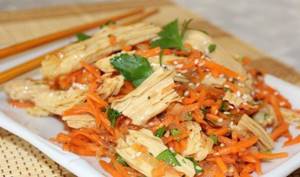
BZHU is: 40%, 40% and 18% respectively.
Important! Remember that asparagus is very high in calories. When following a diet that includes this product, you need to use the calorie table and not exceed the prescribed portion of fuju in food.
For diabetes
Soybean asparagus contains a fairly large amount of easily digestible proteins, which give the body a large boost of energy. It is for this reason that people with diabetes are recommended to use it. Due to the stability of soy, insulin levels will not change dramatically.
For pancreatitis
Soy has a very active effect on the pancreas, so if you have problems with the pancreas, in particular pancreatitis, you should minimize your consumption of fuju. Better yet, avoid this product altogether, otherwise there is a risk of exacerbating the disease.
For gout
Gout is a good reason to be careful when eating foods containing soy.

Since fuzhu contains many elements that promote the elimination of phosphates, chlorides and urea, it may not be safe for people suffering from this disease.
Important! Having gout significantly reduces the serving size of asparagus in your meal. You can eat foods containing fuju up to three times a week in a volume of about 100 grams.
How to choose
There are no difficulties in choosing soybean, bean asparagus and salicornia. But real asparagus contains certain secrets. The asparagus harvest season begins at the end of March and ends at the end of June. It is believed that early shoots are the most tender and delicious. When buying asparagus, you need to pay attention to the length of the sprouts.
The most delicious specimens should not be longer than 15 cm from the top. You also need to pay attention to the shape and density of the shoots: in high-quality asparagus they are round (not flat or ribbed), elastic and not too thin, with a uniform color (no dots or spots) and dense, closed tips. Fresh stems are odorless. High-quality packaging should not contain condensation.
What are the benefits of soy asparagus?
It is often called the “product of youth”: fuzhu has a high concentration of essential plant protein, which is absorbed by the body much faster and easier than animal protein. Soy asparagus has many health benefits, but some studies show that it can also be harmful if consumed in excess. Eating fuju in a very large amount negatively affects the functioning of the pancreas and thyroid gland, and also harms the digestive processes due to its high fiber and protein content.
This product contains bioactive substances - phytoestrogens. For women, they are of great benefit: consuming soy asparagus during PMS, menopause, or when the reproductive system is unhealthy will help reduce the risk of developing serious diseases and reduce harm from the influence of unfavorable factors. Isoflavones, a type of phytoestrogens contained in fuju, which have many beneficial properties, are excellent antioxidants, normalize hormone function, and promote anti-carcinogenic changes. Soy asparagus contains a special substance, lecithin, whose properties improve liver function and prevent the accumulation of fat in the body.
Soy Asparagus Recipes
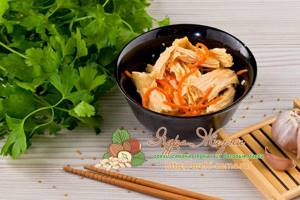
How to cook Fuzhu soy asparagus
Classic salad with fuju
Ingredients:
- 200 g dried asparagus;
- 1 medium onion;
- 2 medium carrots;
- 5 cloves of garlic;
- 3 tbsp. spoons of vinegar (3% or 1 tbsp. 9%);
- sugar – 1 tsp;
- soy sauce – 3 tbsp;
- salt – 1.5 tsp;
- ground coriander – ½ tsp;
- vegetable oil;
- black and red pepper, parsley, sesame seeds.
Preparation:
- Soak asparagus in water according to package instructions. On average, it takes 6 to 8 hours.
- Mix red pepper, sugar, chopped garlic clove, vinegar, soy sauce and a couple of tablespoons of vegetable oil. For stronger spiciness, you can add more black and red pepper.
- Peel the carrots and grate them with long thin sticks (graters have special knives for Korean carrots).
- Add salt to the bowl with carrots and mash the vegetable with your hands until separated and softened.
- Drain the water from the asparagus, squeeze it a little and cut into slices. Wide pieces can be cut lengthwise.
- Mix fuju and carrots.
- Finely chop the onion and two cloves of garlic, fry in 80-100 ml of vegetable oil until translucent.
- Reduce heat by half, add ½ tablespoon of hot red pepper and coriander to the onion. Stir and after half a minute pour this dressing over the carrots.
- Mix the mixture well, add salt, squeeze out 2 garlic cloves. Check for salt.
- Add the dressing prepared in the second step and mix the salad.
- Garnish with toasted sesame seeds and herbs before serving.

Recipe for making Fuzhu soy asparagus in Korean
Korean asparagus with beans
Ingredients:
- dry fuju – 100 g;
- green beans – 150-200 g;
- carrots – 1 pc.;
- onion – 1 pc.;
- garlic – 3 teeth;
- soy sauce – 3 tbsp;
- vegetable oil - 2 tbsp; salt, black pepper.
Preparation:
- Soak the asparagus in water and squeeze out the water.
- Cut the onion into thin half rings.
- Grate the carrots on a coarse grater or cut into long thin strips.
- Chop the garlic.
- Cut the asparagus into strips or slices.
- Mix all the products, add salt and pepper, squeeze a little with your hands to release the juice from the vegetables. Season with soy sauce and oil.
Roasted asparagus
- Soak 0.5 kg of asparagus in water.
- Finely chop a small onion and carrot, fry in hot oil for 5-7 minutes.
- Add asparagus to the vegetables, add salt, stir quickly and reduce heat to low.
- Simmer the food under the lid for 5-7 minutes.
- Finely chop the herbs and three cloves of garlic. Add them to the soy sauce, stir and pour into the pan.
- Keep the dish covered for another 5 minutes on low heat.
- Use with a side dish of steamed rice.
Use in cooking
Asparagus soybean is especially popular in Asian countries. The Chinese most often consume dried fuju, while the Japanese, on the contrary, prefer fresh. Basically, this ingredient is a snack or its component, but the most prized is fuju, soaked in soy sauce. Chinese noodles are also prepared using this component.
Dried fuju also needs preliminary preparation before use. It must be soaked in water so that the fibers are saturated with liquid. Reconstituted fuju acquires a delicate taste and elastic consistency.
Asparagus can be prepared as an independent dish or as a snack. Fuzhu lends itself well to cooking, frying, and is also used in soups, hot dishes, and salads.

Thus, soy asparagus is a healthy product, and various ways of consuming it will diversify the menu and enrich the body with the substances necessary to maintain health.
Calculation of calorie content of a recipe per 440 grams
The calculation of the calorie content of 440 grams of the recipe is based on the summarized indicators of BZHUK (abbreviation: proteins-fats-carbohydrates-acids) of the ingredients from table (1) involved in the preparation. The data was taken from the database of the “products” section of the website and brought into line with the final yield of the dish (net).
Our example involves proteins - 8.76 grams, fats - 20.48 grams and carbohydrates - 14.72 grams, contained in 440 grams of the recipe. Next we perform the calculation:
Energy value of 440 grams of recipe = 8.76 (proteins)*4 + 20.48 (fat)*9 + 14.72 (carbohydrates)*4 = 35.04 + 184.32 + 58.88 = 278.2 kcal
Korean asparagus dressing
The most important ingredient in preparing fuju salads and dishes is the Korean asparagus dressing. Classic options include garlic, oil, spices and soy sauce. The original ones contain sesame seeds, wine vinegar, mushrooms and herbs. Korean-style asparagus will turn out delicious with the following variety of dressings, which need to be mixed thoroughly:
- garlic, bay leaf, apple cider vinegar, red pepper;
- green onions, sesame oil, lemon juice, coriander;
- garlic, soy sauce, vinegar, onion, parsley, cilantro, dill;
- garlic, onion, coriander, sesame, soy sauce, paprika;
- vinegar, garlic, coriander, onion, ginger.
